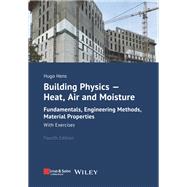
Building Physics: Heat, Air and Moisture Fundamentals and Engineering Methods with Examples and Exercises
by Hens, Hugo S. L.-

This Item Qualifies for Free Shipping!*
*Excludes marketplace orders.
Buy New
Rent Textbook
Rent Digital
Used Textbook
We're Sorry
Sold Out
How Marketplace Works:
- This item is offered by an independent seller and not shipped from our warehouse
- Item details like edition and cover design may differ from our description; see seller's comments before ordering.
- Sellers much confirm and ship within two business days; otherwise, the order will be cancelled and refunded.
- Marketplace purchases cannot be returned to eCampus.com. Contact the seller directly for inquiries; if no response within two days, contact customer service.
- Additional shipping costs apply to Marketplace purchases. Review shipping costs at checkout.
Summary
This book deals with heat, air and moisture transport in building parts or assemblies and whole buildings with emphasis on the building engineering applications.
Compared to the third edition, this fourth edition has been expanded in chapter 1 to include the physical determination of the thermal conductivity of materials, together with an in-depth discussion of all the effects of thicker insulation layers. In chapter 2, additional information has been added on wind pressure and the evaluation of condensation inside the building com-ponents, while a new chapter 4 on material properties has been included. The whole book, including the figures, has been revised and restructured where necessary.
Author Biography
Table of Contents
1. Heat Transfer
1.1 Generalities
1.2 Conduction
1.3 Heat Exchange at Surfaces by Convection and Radiation
1.4 Building Related Applications
1.5 Problems
2. Mass Transfer
2.1 Generalities
2.2 Air
2.3 Water Vapour
2.4 Moisture
2.5 Problems
3 Heat, Air, and Moisture Combined
3.1 Why?
3.2 Material and Assembly Level
3.3 Whole Building Level
3.4 Problems
4. Heat, Air, Moisture Material Properties
4.1 In general
4.2 Dry Air and Water
4.3 Thermal Properties
4.4 Air Properties
4.5 Moisture Properties
5. Postscript
6. Problems and Solutions
An electronic version of this book is available through VitalSource.
This book is viewable on PC, Mac, iPhone, iPad, iPod Touch, and most smartphones.
By purchasing, you will be able to view this book online, as well as download it, for the chosen number of days.
Digital License
You are licensing a digital product for a set duration. Durations are set forth in the product description, with "Lifetime" typically meaning five (5) years of online access and permanent download to a supported device. All licenses are non-transferable.
More details can be found here.
A downloadable version of this book is available through the eCampus Reader or compatible Adobe readers.
Applications are available on iOS, Android, PC, Mac, and Windows Mobile platforms.
Please view the compatibility matrix prior to purchase.
